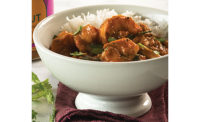Foods and the Future

Higher meat prices: The drought of 2012 is bound to have long-term ramifications. Beef, which has a longer feedlot-to-table cycle, is likely to be hardest hit, although the price for chicken and other animal protein [including eggs] will probably rise. As the prices of feed grains such as corn and soybeans skyrocketed following crop devastation, cattle farmers culled herds to reduce feed costs. The U.S. Agriculture Department and other analysts predict a steady rise in prices.
No stopping yogurt: Yogurt has become a mealtime standby, and there appears to be no stopping its growth in popularity. Research firm Dataessential reports that the simple dairy product appears on 36% more of the nation's restaurant breakfast menus than in 2008.
On the retail side, Greek yogurt -- a form that is strained to produce velvety curd with a dense, creamy richness and almost no fat -- has clobbered conventional varieties. Chobani leads the way. Almost unheard-of five years ago, the brand today accounts for 17% of overall sales, more than twice that of veteran Yoplait Original, according to Bloomberg News reports.
Popcorn's exploding: Imaginative chefs and food manufacturers are dressing up those humble kernels -- a low-cost, high-volume and healthful snack food -- with an array of spices. Catersource magazine predicts popcorn "bars" featuring elaborately spiced varieties showing up at more events. Food & Wine magazine predicts that other popped grains (to "add a texture jolt") will appear on dressy restaurant plates.
Locally sourced food: Only the most oblivious consumer has missed the increasing presence of locally grown and produced foods in almost every retail store -- let alone a steadily increasing number of farmers markets and roadside stands. Now expect more such sourcing on restaurant menus. In a poll of nearly 2,000 American Culinary Federation chefs by the National Restaurant Association, "local" marks the top two menu trends for 2013. Locally sourced meats and seafood ranked just ahead of locally grown produce.
Bold, imaginative flavors: Flavoring trends may be shaped by celebrity chefs and regional influences, but a marketing powerhouse can take them global. McCormick & Co. isolated a few key influences in its annual Flavor Forecast:
Sumptuous and assertive flavors such as bitter chocolate, even combined with passion fruit and sweet basil or black rum, charred orange and allspice.
• Handcrafted flavor combinations that produce an exotic yet comfortably rustic taste. One popular blend includes smoked tomato, chile peppers, sweet onion and rosemary, which together go well with sauces, jams and homemade ketchups (all of which are growing in popularity).
• Global marriages that reflect a cook's individual creativity. Anise, a traditionally Mediterranean flavor, paired with the Mexican caramel sauce called cajeta, merges richness with surprising piquancy.
Watching the weight: Citing research from Sterling-Rice Group, Restaurant Hospitality magazine editors note increasing awareness of healthful dining among chefs. "In 2013, chefs will be working quietly behind the scenes to make your dishes better for you with ingredients like brown rice, high-fiber grains" and vegetables, SRG says.
Allergy awareness: "Gluten," "peanut allergy," "wheat belly" and "dairy sensitivity" are a few of the buzzwords common to modern food talk. More and more supermarkets offer niche products once hidden away in health-food stores. States such as Massachusetts and Rhode Island have enacted legislation requiring allergy-awareness posters to make foodservice workers aware of risks and responsibilities. Expect more products, educational initiatives and rulings.
Age-targeted eateries: Experts asked by Nation's Restaurant News to indicate the attributes of various consumer categories (say, millennials born from the late 1970s to the mid-1990s) found that young consumers tend to exhibit more global awareness and imagination in their menu choices and select food prepared with greater social responsibility [fair trade and naturally grown products] and integrity.
Hold the bread and butter: Though it may annoy those who grew up with bottomless bread baskets, restaurants are dispensing with that perk. The combination of carb-cautiousness, increased costs and impact on appetizer sales are the reason. Food & Wine magazine notes that smart chefs are making it worth the customers' while to ante up a couple of bucks for fresh housemade slices with extra-virgin olive oil and fine butter.
New beverage offerings: Technomic sees three major shifts in what consumers drink when dining out: more sweet table wines, including sparkling pinks and red blends with a softer and a medium-bodied profile; robust beer lists, and not just in casual dining spots; and ciders, which pair easily with food.
Customization: It will be more common to find chefs willing to accommodate an individual's preference. "Gone are the days when chefs can ignore dietary requests. They are just too pervasive," says a Sterling-Rice Group director. Better places are setting aside kids menus of mac-and-cheese or hot dogs in favor of more imaginative [and healthier] child-friendly fare. Even some national chains, such as Red Robin, Denny's and Sbarro, are recognizing the demand.
Expect the exotic: 20 years ago, who knew kimchi, smoked paprika or sriracha? Most forecasters note that whatever the ethnic or cultural derivation, there is a sizable population of consumers willing to take a taste -- and buy.
Looking for a reprint of this article?
From high-res PDFs to custom plaques, order your copy today!





